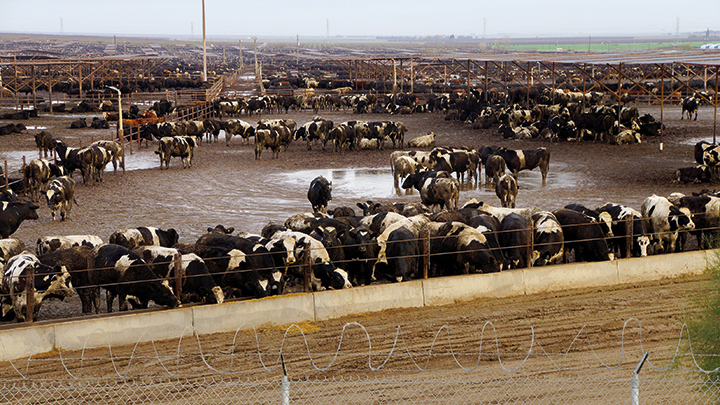The cost of a carnivore
October 1, 2017

We talk a lot about reducing greenhouse gases, climate change, pollution, and emissions from vehicles and industry, and we lament the destruction this is causing to the environment. We tell ourselves to save water and we get upset about the destruction of the world’s rainforests. Many of us don’t know, however, that what we choose to put on our plates has an impact on the environment that’s even more devastating than some of these other factors.
Those greenhouse gases
Animal agriculture isn’t usually included in the catalogue of environmental culprits but it is in fact the most destructive industry impacting the planet today. Animals being raised for food create 51 per cent of global greenhouse gas emissions, as opposed to 13 per cent from transport. Livestock are responsible for more than half of nitrous oxide emissions worldwide, which is 24 per cent more destructive to our atmosphere than carbon dioxide. And carbon dioxide makes up only 0.03 per cent of the atmosphere, so it isn’t a real greenhouse gas, because unlike methane and nitrous oxide, it’s heavier than air, so it doesn’t float into the upper atmosphere.
And there’s more . . .
And that’s only the beginning of our planet’s woes. At present, it’s calculated that one-third of Earth’s total land has been turned into desert because of livestock. For example, the deserts of the Middle East are, to a large extent, the result of overgrazing by sheep and goats over millennia. Desertification is also caused when land is cleared and trees removed—trees which protect against erosion by wind and water. Clearing also aids the encroachment of wind-blown sands from deserts. It isn’t a desert yet, but the Amazon basin is currently being cleared at a horrendous rate, almost entirely for animal grazing and the planting of palm oil trees. And the same thing is happening in Indonesia and other Asian countries.
Livestock currently take up 45 per cent of what remains of Earth’s total arable land, and demand is increasing exponentially thanks to our appetite for meat. Admittedly, a proportion of current grazing land cannot be used for farming. But, on average, nine hectares of land is required to feed one person on a meat diet versus less than half a hectare of land that’s needed to feed one vegetarian. The largest (91 per cent) contributor to deforestation is the desire for more land for animal agriculture! With a massive proportion of deforestation occurring in the Amazon rainforest the problem of species extinction is compounding the problem.
Trouble at sea
A similar situation exists in the marine world, where for every kilogram of fish caught for human consumption, five kilograms are discarded as “bycatch.” With 80.4 million metric tonnes of fish pulled from the oceans each year, that’s a lot of species unintentionally and needlessly caught and killed.
Two-thirds of planet Earth is covered by water, of which 97 per cent is salted and 2 per cent is frozen. So only 1 per cent of all the world’s water is available for human consumption, but sadly, we’re doing a great job of polluting it. Most of the pollution doesn’t come from heavy industry, as you may think; it comes from the animal-rearing industries. In one prominent example, it’s consistently claimed that this nutrient-rich runoff is destroying Australia’s amazing Great Barrier Reef.
Water pollution
A study in the United States showed that 3000 tonnes of excrement is produced every minute by animals raised for food. Waste from 2500 dairy cows produces the same amount of waste as a human population of more than 400,000 people! A significant amount of animal waste gets washed into our waterways, because, unlike cities, which have effluent plants to deal with human excrement, some farms, particularly dairy, have, at best, oxidation ponds, which are less effective.
Nine hectares of land is required to feed one person on a meat diet versus less than half a hectare of land that’s needed to feed one vegetarian.
The nutrient runoff from animal agriculture also causes “dead zones” in our oceans and waterways, where reduced levels of oxygen (hypoxia) cause marine life to either die or leave.
Best use of limited resources
And speaking of water, are you aware that the meat and dairy industries use one-third of the earth’s fresh water? It takes 3000 litres of water to produce one hamburger patty (including the time it takes to grow the cow to slaughter stage and then process the patty to eating stage). That’s the equivalent of two months’ worth of showers! If you chose to continue to enjoy long showers and brush your teeth with the tap on, but reduced your meat consumption, you would save infinitely more water than by simply taking “navy” showers where you turn off the flow of water during the middle, lathering phase of the shower.
As you can see, the single most comprehensive factor leading to the destruction of earth’s environment and the breakdown of the biosphere is the production of animals for human consumption. In purely arithmetic terms, this world could support 27 times its current population if we were all vegetarian. A plant-based diet cuts your carbon footprint by 50 per cent, making our planet a healthier place to live—a worthwhile addition to the personal health benefits of a vegetarian diet.







